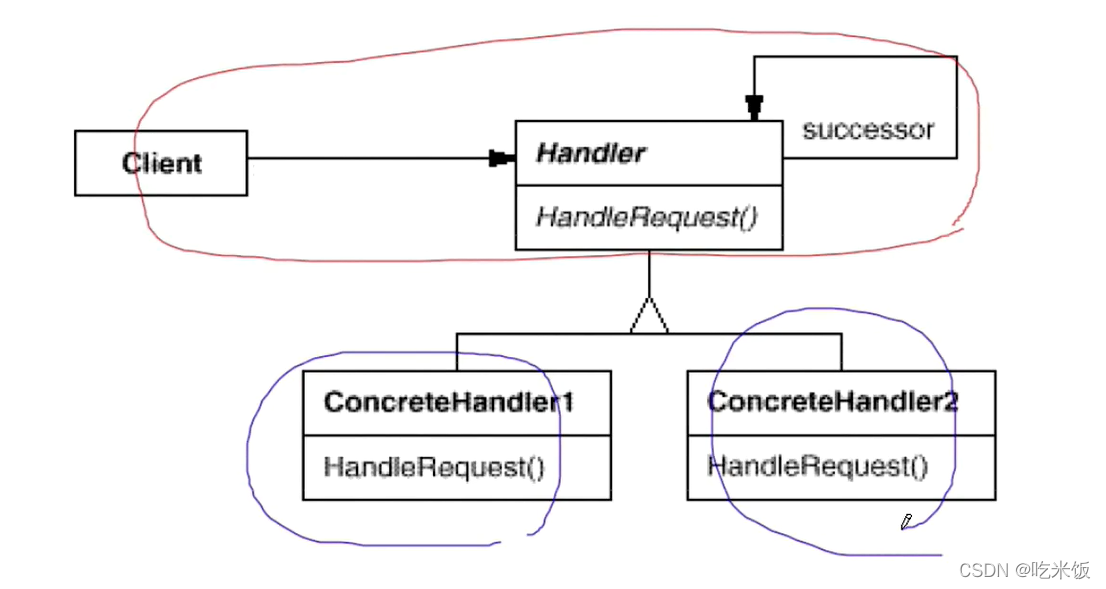数据结构模式
- 常常有一-些组件在内部具有特定的数据结构,如果让客户程序依赖这些特定的数据结构,将极大地破坏组件的复用。这时候,将这些特定数据结构封装在内部,在外部提供统一的接口,来实现与特定数据结构无关的访问,是一种行之有效的解决方案。
典型模式
Chain of Resposibility
动机( Motivation )
- 在软件构建过程中, -个请求可能被多个对象处理,但是每个请求在运行时只能有一个接受者,如果显式指定,将必不可少地带来请求发送者与接受者的紧耦合。
- 如何使请求的发送者不需要指定具体的接受者?让请求的接受者自己在运行时决定来处理请求 ,从而使两者解耦。
模式定义
使多个对象都有机会处理请求,从而避免请求的发送者和接收者之间的耦合关系。将这些对象连成一条链,并沿着这条链传递请求,直到有一个对象处理它为止。
结构

要点总结
- Chain of Responsibility模式的应用场合在于“一个请求可能有,多个接受者,但是最后真正的接受者只有一个”, 这时候请求发送者与接受者的耦合有可能出现“变化脆弱”的症状,职责链的目的就是将二者解耦,从而更好地应对变化。
- 应用了Chain of Responsibility模式后,对象的职责分派将更具灵活性。我们可以在运行时动态添加/修改请求的处理职责。
- 如果请求传递到职责链的末尾仍得不到处理,应该有一个合理的,缺省机制。这也是每一个接受对象的责任,而不是发出请求的对象的责任。
cpp
#include<iostream>
#include<string>
enum class RequestType
{
REQ_HANDLER1,
REQ_HANDLER2,
REQ_HANDLER3
};
class Reqest
{
public:
Reqest(const std::string& desc, RequestType type) :description(desc), reqType(type) {}
RequestType getReqType()const { return reqType; }
const std::string& getDescription()const { return description; }
private:
std::string description;
RequestType reqType;
};
class ChainHandler
{
public:
ChainHandler() :nextChain(nullptr) {}
void setNextChain(ChainHandler* next) { nextChain = next; }
void handle(const Reqest& req)
{
if (this->canHandleRequest(req))
{
this->processRequest(req);
}
else
{
this->sendReqestToNextHandler(req);
}
}
protected:
virtual bool canHandleRequest(const Reqest&) = 0;
virtual void processRequest(const Reqest&) = 0;
private:
void sendReqestToNextHandler(const Reqest& req)
{
if (nextChain != nullptr)
{
nextChain->handle(req);
}
}
private:
ChainHandler* nextChain;
};
class Handler1 :public ChainHandler
{
public:
virtual bool canHandleRequest(const Reqest& req)
{
return req.getReqType() == RequestType::REQ_HANDLER1;
}
virtual void processRequest(const Reqest& req)
{
std::cout << "Handler1 is handle reqest: " << req.getDescription() << std::endl;
}
};
class Handler2 : public ChainHandler {
protected:
bool canHandleRequest(const Reqest& req) override
{
return req.getReqType() == RequestType::REQ_HANDLER2;
}
void processRequest(const Reqest& req) override
{
std::cout << "Handler2 is handle reqest: " << req.getDescription() << std::endl;
}
};
class Handler3 : public ChainHandler {
protected:
bool canHandleRequest(const Reqest& req) override
{
return req.getReqType() == RequestType::REQ_HANDLER3;
}
void processRequest(const Reqest& req) override
{
std::cout << "Handler3 is handle reqest: " << reqc.getDescription() << std::endl;
}
};
int main()
{
Handler1 h1;
Handler2 h2;
Handler3 h3;
h1.setNextChain(&h2);
h2.setNextChain(&h3);
Reqest req("process task ... ", RequestType::REQ_HANDLER3);
h1.handle(req);
return 0;
}